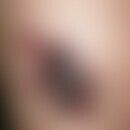Synonym(s)
HistoryThis section has been translated automatically.
DefinitionThis section has been translated automatically.
Rare, life-threatening, fulminant, deep, phlegmonous infection of the skin, subcutis and fascia, possibly also of the musculature, often occurring after banal injuries, no bone involvement (Goh T et al.2014).
You might also be interested in
PathogenThis section has been translated automatically.
Based on the spectrum of pathogens detected, 4 types can be distinguished:
- Type1: Polymicrobial mixed infection. Mixed infection mostly combinations of various anaerobic bacteria (e.g. Bacteroides, Peptostreptococcus spp.) and facultative anaerobic bacteria (e.g. non-A streptococci) and enterococci (e.g. E. coli, Enterobacter, Klebsiella, Proteus).
- Type2: Group A streptococci (Streptococcus pyogenes) with or without concomitant infection by Staphylococcus aureus or epidermidis.
- There are also isolated reports of infections with multi-resistant germs such as Acinobacter baumannii, an opportunistic gram-negative, coccoid rod bacterium.
- Type3 (rare): Vibrio spp.
- Type4 (rare): Candida spp.
NFKB1-associated sterile familial autoinflammatory necrotizing fasciitis(FANF), a very rare (limited to a few cases worldwide), autoinflammatory systemic disease associated with an LOF mutation R157X in the NFKB1 gene, has been described (Bergbreiter A et al.2021). Fasciitis usually develops after banal (minor) surgical procedures.
Occurrence/EpidemiologyThis section has been translated automatically.
Low incidence; figures of 0.4/100,000 inhabitants are given for Europe. m:w=2-3:1;
EtiopathogenesisThis section has been translated automatically.
Mostly after banal injuries, but also after surgical wounds or injuries with infected injection needles from drug addicts. Bacterial toxins or the deposition of bacterial and cellular decay products in the event of inadequate removal are held responsible for the necrotizing course of the disease.
Monogenic familial autoinflammatory fasciitis (see below NFKB1-associated autoinflammatory diseases, FANF) is caused by a "truncating" mutation R157X in the NFKB1 gene. This disease was described in two brothers who suffered from localized, recurrent, sterile, necrotizing inflammation after banal tissue trauma (e.g. after minor surgery) that spread to the muscle fascia (clinical picture of necrotizing fasciitis). The patients had no other organ or systemic involvement nor any obvious manifestations of immunodeficiency (Kaustio M et al. 2017).
LocalizationThis section has been translated automatically.
Extremities, especially lower legs, also forearms starting from the back of the hand. Also lower abdomen, genital area(gangraena acuta genitalium).
ClinicThis section has been translated automatically.
Start with high septic temperatures (80%), severe disturbance of the general findings and severe local pain (79%). Pain in the early stages often appears disproportionately severe in view of the low or absence of visible skin lesions.
The skin initially shows a circumscribed, overheated redness (80%) with swelling and subsequently a subcutaneous nodular, almost board-like, painful induration.
Rapid transition to haemorrhagic infarction of the subcutis, secondarily also of the fascia and the musculature (compartment syndrome); in surgical intervention, a muscle melting under the hands is found. In this stage the skin appears bluish-livid, large blistered and lifted.
Note: Diabetes mellitus (detected in about 45% of cases), glucocorticoid therapy, alcoholism, intravenous drug abuse, liver cirrhosis and tumor diseases are considered risk factors (Goh T et al. 2014).
Note: A special form of necrotizing fasciitis affecting the scrotum or vulva is Fournier's gangrene.
LaboratoryThis section has been translated automatically.
Inflammation parameters (CRP, BSG) massively increased, leucocytosis, neutrophilia; CK, amylase increased.
Draw blood cultures!
DiagnosisThis section has been translated automatically.
Clinic, laboratory, sonography of the affected muscle boxes, MRI.
Complication(s)(associated diseasesThis section has been translated automatically.
Involvement of joints as well as vascular nerve cords, consumption coagulopathy.
TherapyThis section has been translated automatically.
Combination of radical surgical debridement with removal of fascia and infected soft tissues. Immediate wide surgical opening, extensive debridement of the necrotic area to where the skin and subcutaneous tissue can no longer be separated from the fascia. Ablation of necrotizing portions, cleaning of the wound bed, open wound treatment. 24-36 hours, a revision ("second look") should be performed again for possible resection and wound irrigation.
In addition, high-dose antibiotic therapy must be given with broad-spectrum antibiotics such as piperacillin and tazobactam or by means of reserve antibiotics such as carbapenem.
Antibiotic therapy alone is usually not sufficient!
Internal therapyThis section has been translated automatically.
High-dose parenteral antibiotic therapy as soon as possible after antibiogram. Collect wound swabs and blood cultures several times! Information to the laboratory, 3 times 2 venous blood cultures per 24 hrs are sufficient for pathogen detection.
Standard therapy is a combination of penicillin G and an aminoglycoside (gentamicin), since a synergistic effect of both substances is achieved even when pathogens are not very sensitive to aminoglycosides alone. Penicillin G 5 million IU at TD of 20-30 million IU., gentamicin (e.g., Refobacin) 3-5 mg/kg bw/day in 1 ED slowly i.v. (short infusion). If anaerobes are detected, additionally clindamycin (e.g. Sobelin) 4 times/day 300-600 mg (up to 3 times/day 600 mg) i.v. In case of penicillin intolerance, vancomycin 2 times/day 1 g or 4 times/day 500 mg i.v. (1 h infusion) or teicoplanin (e.g. Targocid) 400 mg on day 1, followed by 1 time/day 200 mg i.v. from day 2. The duration of therapy is to be adapted to the clinical conditions. Alternatively, linezolid (Zyvoxid) 600 mg i.v. 2 times/day.
The administration of glucocorticoids is evaluated differently. While glucocorticoids are sometimes accused of playing a role in the pathogenesis of the disease, other authors consider their inhibitory effect on the tumor necrosis factor and the resulting stabilization of the cell membrane to be a possibly life-saving factor.
Progression/forecastThis section has been translated automatically.
In a collective of 15 patients with necrotizing fasciitis (Leiblein M et al. 2018), no patient died during the observation period.
Two patients required limb amputation. Diabetes mellitus was associated with a significantly higher risk of amputation. The average hospital stay was 32 days, including 8 days in the intensive care unit (Leiblein M et al. 2018).
Lethal outcome in up to 15-20% of cases (sepsis; this figure is not so confirmed in other studies).
Note(s)This section has been translated automatically.
Fournier's gangrene affecting the external genitalia (vulva/scrotum) is a special form of necrotizing fasciitis.
LiteratureThis section has been translated automatically.
- Ballon-Landa GR (2001) Necrotizing fasciitis due to penicillin-resistant Streptococcus pneumoniae: case report and review of the literature. J Infect 42: 272-277
- Ben M'Rad M et al. (2002) A case of necrotizing fasciitis due to Streptococcus pneumoniae following topical administration of nonsteroidal anti-inflammatory drugs. Clin Infect Dis 35: 775-776
- Dahl PR (2002) Fulminant group A streptococcal necrotizing fasciitis: clinical and pathologic findings in 7 patients. J Am Acad Dermatol 47: 489-492
- Fustes-Morales A Necrotizing fasciitis: report of 39 pediatric cases. Arch Dermatol 138: 893-899
- Frick S et al. (2001) Necrotizing fasciitis due to Streptococcus pneumoniae after intramuscular injection of nonsteroidal anti-inflammatory drugs: report of 2 cases and review. Clin Infect Dis 33: 740-744
- Goh T et al.(2014) Early diagnosis of necrotizing fasciitis. Br J Surg 101:e119-125.
- Heitmann C (2001) Surgical concepts and results in necrotizing fasciitis. Chirurg 72: 168-173
- Kaustio M et al. (2019) Primary immunodeficiency, a possible cause of neutrophilic necrotizing dermatosis. JAMA Dermatol. 155:863-864.
- Kulasegaran S et al. (2015) Necrotizing fasciitis: 11-year retrospective case review in South Auckland. ANZ J
Surg doi: 10.1111/ans.13232 Leiblein M et al. (2018) Necrotizing fasciitis: treatment concepts and clinical results. Eur J Trauma Emerg Surg 44:279-290.
- Myslinski W (2003) Nonsteroidal anti-inflammatory drugs overdosage--the cause or the consequence of necrotizing fasciitis? J Eur Acad Dermatol Venereol 17: 227-228
- Vorpahl U et al. (1996) Fasciitis necroticans, clinical course - diagnosis - therapy. Phlebology 25: 69-72
- Wagner JA et al. (2011) Necrotizing fasciitis caused by Acinobacter baumannii. Dermatology 62: 128-130
- Wilson B (1952) Necrotizing fasciitis. Am Surg 18: 416-431
- Wong CH et al. (2003) Necrotizing fasciitis: clinical presentation, microbiology, and determinants of mortality. J Bone Joint Surg Am 85: 1454-1460
Incoming links (11)
Gangrene, postoperative progressive; Infectious diseases of the skin; Myonecrosis, clostridial; Necrotizing fasciitis; NFKB1-Associated Autoinflammatory Diseases; Panniculitis nodularis nonsuppurativa; Phlegmons; Streptococcus; Streptococcus gangrene; Streptococcus pyogenes; ... Show allOutgoing links (19)
Aminoglycosides; Antibiogram; Antibiotics; Clindamycin; Disseminated intravascular coagulation; Fournier gangrene; Gentamicin; Glucocorticosteroids; Glucocorticosteroids systemic; Linezolid; ... Show allDisclaimer
Please ask your physician for a reliable diagnosis. This website is only meant as a reference.









